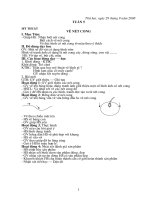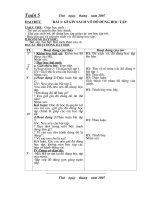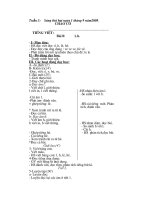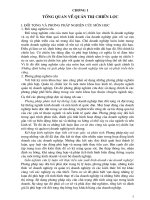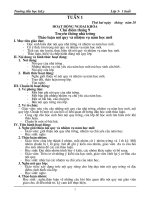5 6 1 marine life
Bạn đang xem bản rút gọn của tài liệu. Xem và tải ngay bản đầy đủ của tài liệu tại đây (5.7 MB, 14 trang )
Suggested levels for Guided Reading, DRA,™
Lexile,® and Reading Recovery™ are provided
in the Pearson Scott Foresman Leveling Guide.
Genre
Expository
nonfiction
Comprehension
Skills and Strategy
• Draw Conclusions
• Graphic Sources
• Visualize
Marine
Life
Text Features
•
•
•
•
Glossary
Captions
Headings
Sidebar
Scott Foresman Reading Street 5.6.1
ISBN 0-328-13577-1
ì<(sk$m)=bdfh g< +^-Ä-U-Ä-U
by Mary Miller
Life Science
Reader Response
1. You read about coral reefs on pages 16–18. Draw a
conclusion about how we should treat coral reefs.
Combine what you have read with what you already
know. Use a chart like the one below to record your
answers.
Marine
Life
Facts about reefs
Conclusions
2. Visualize the way the different creatures you’ve read
about feed. How are they similar? How are they
different from one another?
by Mary Miller
3. On page 10, the word hammocks is used to create an
idea. What does hammock really mean? What is the
word used to suggest on page 10?
4. Some of the sea creatures described in this book are
able to change color. Using examples from the book,
explain how the ability to change color can save an
animal from danger.
Editorial Offices: Glenview, Illinois • Parsippany, New Jersey • New York, New York
Sales Offices: Needham, Massachusetts • Duluth, Georgia • Glenview, Illinois
Coppell, Texas • Ontario, California • Mesa, Arizona
An Ocean Home
Every effort has been made to secure permission and provide appropriate credit for
photographic material. The publisher deeply regrets any omission and pledges to
correct errors called to its attention in subsequent editions.
More than seventy percent of Earth is covered by
water. Most of it is in the Earth’s oceans. Earth has
four oceans: the Atlantic Ocean, the Pacific Ocean, the
Indian Ocean, and the Arctic Ocean. These oceans meet
the land along rocky coastlines, sandy beaches, salt
marshes, and mud flats. People enjoy many activities
along these coasts. Children play on sandy beaches.
People hike along rocky coastlines. Birdwatchers visit
salt marshes to look for migrating seabirds.
Because most of the living things you see every
day are on land, you might think that life stops at
the ocean shore. However, these coastlines and the
ocean waters near them are homes to thousands of
life forms.
Unless otherwise acknowledged, all photographs are the property of Scott Foresman,
a division of Pearson Education.
Photo locators denoted as follows: Top (T), Center (C), Bottom (B), Left (L), Right (R),
Background (Bkgd)
Opener ©Stuart Westmorland/Corbis; 1 ©Stuart Westmorland/Corbis; 3 ©Warren
Morgan/Corbis; 5 ©Kennan Ward/Corbis; 6 (TR) ©Peter Steiner/Corbis, 6 ©Stuart
Westmorland/Corbis; 7 © M. Harvey/Animals Animals/Earth Scenes; 9 ©David Muench/
Corbis; 10 ©Stuart Westmorland/Corbis; 11 (T) ©Raymond Gehman/Corbis, 11 (Inset)
©Brandon D. Cole/Corbis; 13 ©Scott T. Smith/Corbis; 14 ©Jeffrey L. Rotman/Corbis;
15 ©Anthony Redpath/Corbis; 16 ©Lawson Wood/Corbis; 18 ©Stuart Westmorland/
Corbis; 19 (B) ©Theo Allofs/Corbis, 19 (Inset) ©Ron Watts/Corbis; 20 (B) ©Stephen
Frink/Corbis, 20 (Inset) ©Stuart Westmorland/Corbis; 21 ©Royalty-Free/Corbis, 21 (Inset)
©Stephen Frink/Corbis, 21 (Inset) ©Amos Nachoum/Corbis; 22 (Inset) ©Lawson Wood/
Corbis, 22 (B) Getty Images; 23 ©Stephen Frink/Corbis
ISBN: 0-328-13577-1
Copyright © Pearson Education, Inc.
All Rights Reserved. Printed in the United States of America. This publication is
protected by Copyright, and permission should be obtained from the publisher
prior to any prohibited reproduction, storage in a retrieval system, or transmission
in any form by any means, electronic, mechanical, photocopying, recording, or
likewise. For information regarding permission(s), write to: Permissions Department,
Scott Foresman, 1900 East Lake Avenue, Glenview, Illinois 60025.
2 3 4 5 6 7 8 9 10 V0G1 14 13 12 11 10 09 08 07 06 05
3
Rocky Coast and Sandy Shore
Ocean coasts are difficult places to live
near. Waves can be large and powerful. Also,
because of tides, the water actually leaves
the shore twice a day. A tide is the cycle
of rising and lowering water that happens
along ocean shores. When the tide goes out,
many ocean animals are left high and dry.
Creatures that live along shorelines have
developed ways of surviving waves and tides.
Many creatures simply bury themselves in the
sand or find a safe place to hide among the
rocks.
Barnacles make a substance that “glues”
them in place. This keeps them from being
swept away by the tide. As the tide comes
in and goes out, it carries small plants and
animals that the barnacle catches and eats.
Mussels create tough, sticky threads,
called byssal threads, to keep themselves in
place. A mussel clings to rocks with about
eighty byssal threads in the winter and thirty
threads in the summer. When the tide goes
out, mussels close up tight so that they won’t
dry out.
4
Mussels
and starfish cling
to a rock exposed
at low tide. 5
Snails also live along the
coastline. Snails have soft bodies
with hard spiral-shaped shells. A
snail has only one foot, which it
uses to hold tightly to rocks so that
it isn’t swept out to sea. There are
thousands of different kinds of
snails. Some species are no larger
than the head of a pin; others are
big enough to feed on oysters and
clams. The snail drills a hole through
the other animal’s shell. It then inserts a long feeding
tube through the hole to reach the meat inside.
The starfish, or sea star, uses its five legs to move
about. Each leg has rows of tiny tube feet with
suckers at the tips. These suckers allow the starfish
to cling to rocks or driftwood during wave surges.
Starfish are not really fish at all. They belong to a
group of creatures called echinoderms. Some other
echinoderms are sand dollars and sea urchins.
6
Mudskippers can use their front
fins to move across mudflats
when the tide is out.
Mud Flats
In the tropics, the ocean tide often washes up on
mud flats or mangrove swamps. Mangroves are short
trees with many stilt roots. They grow in mud and
saltwater along ocean shores. The stilt roots collect
mud, so mangrove swamps and mud flats are often
found together.
One of the strangest creatures found in these
muddy tropical coastlines is the mudskipper. These
unusual fish actually spend more time hopping than
swimming. They use their front fins to “walk” or skip
across the mud. They can even climb trees!
Mudskippers can breathe on land because there
is water trapped in their gills. They do need to stay
wet, however, so they need to stay near the water.
Mudskippers are usually only two to four inches
long, though some varieties of mudskipper grow to
twelve inches in length.
7
Tide Pools
Life on the beach is ruled by the tides.
When the tide goes out, pools of water
are often left behind. Unlike the parts of
the beach that are left high and dry, life
goes on as usual in these pools. Because
of this, tide pools offer us a closer look at
what life is like in the ocean.
In a tide pool, you might see a hermit
crab. Hermit crabs do not have their own
shells. They live in shells that were left
behind by other animals. If you have a
pet hermit crab, it is important to leave
an extra, larger shell in the tank with the
crab. You can use tweezers to place the
new shell near the crab. When a hermit
crab outgrows its shell, it must quickly
find a larger shell in which to live.
Starfish also can be found in tide
pools. The starfish uses the suckers on
its tube feet to grab and force open the
shells of oysters. The starfish then pushes
its stomach out of its body through its
mouth. Chemicals in the stomach digest
the oyster outside of the starfish’s body.
Tide pool
8
9
Sea anemones cling to rocks in the tide pool. With
their delicate colors, they look like beautiful flower
blossoms in the water. But they are not flowers;
they are animals. Sea anemones are not mildmannered—their soft tentacles can sting. It would
be a mistake for most creatures to view anemones
as soft hammocks on which to rest. Anemones wave
their tentacles to catch fish that might swim by
them. A sea anemone will pull in its tentacles when
the tide goes out to keep itself from drying out. But
in a tide pool, the tentacles wave in the water.
Sea urchins are also beautiful to look at but
dangerous to touch. They look like brightly colored
pin cushions. Sharp spikes cover the sea urchin’s soft
body. These spikes discourage other creatures from
wanting to make a meal of the sea urchin. The sea
urchin’s mouth is on its underside. The underside
also has five sharp teeth that are strong enough to
anchor the sea urchin to rock and coral.
A sea anemone looks more
like a flower than an animal.
10
Fiddler crab
Salt Marshes
A salt marsh is an area that is affected by tides
but is protected from big ocean waves and storms. A
strip of land or some other feature keeps things calm
in the salt marsh, while still allowing saltwater to
flow in and out.
Salt marshes often occur near the mouths of
rivers. The rivers deposit dirt, and thick mats of
marsh grass grow in this dirt. Only plants that can
tolerate salt will grow in these marshes. In the water
and among the grasses of the salt marsh, oysters,
shrimps, crabs, and flatfish make their homes.
Fiddler crabs scamper about the marshes at low
tide looking for food. When the water rushes in at
high tide, the crabs go back to their holes. These
crabs are small—usually only an inch across. The
fiddler is named for the male’s huge single claw,
which looks like the crab is holding a violin. Males
wave their large claws to show off for female crabs.
11
The animal known as a horseshoe crab is not
a crab at all. It is related to spiders and scorpions.
Beneath its shell is a body that actually has more
legs than a spider has. The horseshoe crab can
grow as big as twenty inches in length, so it is also
much larger than a spider! This strange creature
burrows in the sand to find food and shelter. While
the horseshoe crab is basically harmless, you still
don’t want to step on that sharp tail spine.
Crabs
Fiddler crabs and hermit crabs are only two of the
thousands of different kinds of crabs that live along the
world’s coastlines. There are king crabs, spider crabs,
snow crabs, red crabs, kelp crabs, and more. Crabs
come in many sizes and colors. Some crabs measure less
than an inch across, but a Tasmanian crab can weigh
20 pounds and have a shell that is 18 inches across.
Crabs have no skeletons inside. It is their shells
that give them shape and make it possible for them
to walk. Crabs generally move with a quick, sideways
motion, rather than walking straight ahead. And
crabs have claws, or pincers, that they can use for
feeding, fighting, or holding on.
One very interesting crab is the ghost crab. These
crabs can seem to appear from nowhere. Their
sand-colored shells and quick movements can make
them seem to disappear before your eyes. Ghost
crabs spend their days digging in the sand to make
burrows. At night, they come out of their burrows to
feed on clams, insects, plants, and other crabs.
12
13
Life on the Bottom
The mud and sand under shallow waters are also
home to a great variety of marine life.
Clams and oysters live in the mud. These creatures
have two hard shells that they can open and close.
A clam has a muscular foot for digging in the mud.
This foot helps the clam bury itself in the sand or
mud. Clams have two tiny tubes, called siphons, for
breathing under the mud. The siphons are pushed
up to the water. One tube inhales water. The clam’s
gills remove the oxygen from the seawater. Then the
seawater is exhaled through the other tube.
Oysters live together in beds. These beds are
large groups of oysters piled on top of each other.
Sometimes, a grain of sand becomes stuck inside an
oyster’s shell. The sand is very irritating to the oyster.
The oyster covers the grain with layers of the same
material it used to make its shell. Over time, a pearl
is formed.
The stingray lives in warm, shallow waters and
dines on the clams and oysters there. The stingray
is a flat fish with a long tail that it
can use like a whip. On the
tail are sharp, poisonous
spines. Many swimmers
Oysters
have lamented their
carelessness at
entering the water;
stepping on a
stingray can lead
to a horribly
painful sting.
Stingray
14
15
Coral Reefs
Coral reefs are beautiful and amazing formations.
Reefs are found in shallow, tropical waters
worldwide, close to the shores of many continents
and islands. The water must be clear and warm for
the reef to thrive. Coral reefs also need plenty of
sunlight. The algae and other sea plants living on the
reef need the sun’s energy to make food.
A coral reef is home to creatures such as fish,
worms, clams, turtles, and eels. Some of Earth’s most
colorful animals live on reefs. The reef may look like
a pile of rocks to you, but it is actually built from the
skeletons of millions of tiny coral animals.
16
There are more than 2,000 different types of
coral. The corals known as stony corals are hard.
There are also many soft corals. Corals can be pink,
green, orange, red, or violet, but most are yellowbrown. Corals get their color from algae that live in
the coral.
The body of the coral animal is called a polyp. The
polyp is hollow and shaped like a cylinder. The base
of the coral polyp is anchored to rock or to other
corals. Tiny tentacles for gathering food surround
the mouth of the coral polyp. Water currents carry
food to the waiting tentacles of the coral polyp.
17
Kinds of Coral Reefs
There are three major types of coral reefs:
fringing reefs, barrier reefs, and atolls. Fringing reefs
are young reefs, and they are smaller in size. They
are found close to the shoreline.
Barrier reefs are found farther from shore than
fringing reefs. These reefs form a barrier between
a lagoon and the open sea. A lagoon is a body of
water separated from the sea. Australia’s Great
Barrier Reef is the largest group of coral reefs in the
world. This barrier reef is about 1,250 miles long.
An atoll is a ring-shaped reef that forms when an
old volcano sinks back into the sea. The reef grows
on the volcano’s rim. The coral builds upward and
can even break the water’s surface and become an
island. There are islands in the
South Pacific that have
formed from atolls.
A large, red-brown sea fan is home to many other sea creatures.
The polyps of stony corals remove minerals from
seawater to build outer skeletons. As polyps die, the
skeletons are left behind, forming the reef. Most coral
reefs grow less than one-fourth of an inch per year. It
takes thousands of years for a large reef to be built up.
Soft corals are the most brightly colored corals.
They grow in colonies that form structures that look
like branches, fingers, or shelves. Soft corals do not
build the reef, but they protect reefs during storms.
Sea fans are corals that are common in shallow
waters. Their branching forms can grow to lengths of
ten feet.
18
Belize’s Lighthouse
Reef Atoll
Australia’s Great Barrier Reef
19
Coral Reef Fish
Corals aren’t the only beautifully colored
creatures living on the reef. Many of the fish that live
near a coral reef come in a dazzling array of colors.
For some fish, their bright colors are camouflage that
allows them to blend in with the colors of the reef
and avoid predators.
Sometimes, a fish’s pattern or bright color serves
as a warning to its predators. The lionfish is one of
the most distinctive reef fish. Its unusual pattern and
sharp spines alert other fish that it is poisonous.
Some fish can change their color. For example,
the blue tang is bright blue during
the day. At night, white bars
appear on its body.
Lionfish
Blue tang
20
School
of fish
Pufferfish
Trumpetfish
Sometimes, reef fish use camouflage to lure and
trap their prey. The trumpetfish can change its color
to match its background. Trumpetfish are long and
skinny. They can make certain parts of their bodies
different colors. If the trumpetfish wants to hunt a
small yellow fish, it can turn only its head yellow. The
rest of the fish’s body would match the background.
The prey would think it was swimming past a small
yellow fish like itself.
Fish living near coral reefs have other tricks with
which to fool their predators and save themselves
from becoming another creature’s dinner. Many
small fish swim together in large schools or groups.
Because they form a larger mass, a school of fish
can trick a potential adversary into thinking they
are one huge fish. The pufferfish also uses the
idea of a larger size to scare away attackers. When
threatened, the pufferfish blows itself up like a
balloon. As a much larger fish, it might scare away a
hungry predator.
21
Eels
Eels are long fish that look a lot like snakes. The
moray eel has strong jaws and sharp teeth. Some
moray eels can grow to ten feet long. During the day,
moray eels stay concealed in holes in the reef. With a
snap of their jaws, moray eels deal sternly with anyone
invading their space. At night, the moray eel leaves its
home to search for crabs or perhaps a small octopus.
Octopus
Like the moray eel, the octopus does not have the
bright colors of tropical fish. An octopus has speed,
cunning, and the ability to change colors.
An octopus has a soft round body, large eyes, and
eight long arms. It can use the suckers on its arms to
move around the ocean floor or it can squirt water
out of a tube and zoom through the water. If an
octopus looses an arm,
it can grow a
new one!
Octopus
Moray eel
Sponges
Sponges are sea animals. Most live in warm
tropical waters. Some sponges are as small as a
peanut. Other sponges can grow as large as a small
car. Sponges come in different shapes. Some look like
giant barrels or flower vases. Sponges can be bright
yellow, orange, purple, gray, or brown.
Sponges attach themselves to rocks, plants, or
coral reefs. Water flowing through a sponge brings
in tiny animals and plant matter.
There are thousands more creatures living in the
oceans and along the shores. These regions are rich
with life, sometimes beautiful and sometimes strange.
Scientists learn more about marine life every day.
22
23
Glossary
algae n. plant or plantlike
organisms that live in
oceans, lakes, rivers, or
ponds. A single organism
is called an alga.
concealed v. hidden from
view.
driftwood n. wood that
drifts or floats in water or
that has been washed up
onshore.
hammocks n. hanging
beds made of fabric and
suspended by ropes on
either side.
Reader Response
lamented v. to have
shown sorrow or regret.
sea urchins n. small,
round sea animals with
spiny shells.
sternly adv. Harshly or
severely.
tweezers n. a metal
instrument with two
pieces joined at one
end for picking up small
objects.
1. You read about coral reefs on pages 16–18. Draw a
conclusion about how we should treat coral reefs.
Combine what you have read with what you already
know. Use a chart like the one below to record your
answers.
Facts about reefs
Conclusions
2. Visualize the way the different creatures you’ve read
about feed. How are they similar? How are they
different from one another?
3. On page 10, the word hammocks is used to create an
idea. What does hammock really mean? What is the
word used to suggest on page 10?
4. Some of the sea creatures described in this book are
able to change color. Using examples from the book,
explain how the ability to change color can save an
animal from danger.
24


